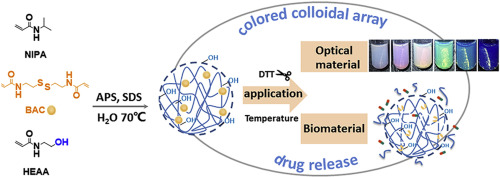Polymer ( IF 4.6 ) Pub Date : 2017-12-30 , DOI: 10.1016/j.polymer.2017.12.066 Xueting Li , Shuchang Yuan , Kenneth J. Shea , Gao Qiu , Xihua Lu , Ruiyun Zhang

|
Redox/temperature responsive poly(N-isopropylacrylamide/N-hydroxyethylacrylamide) (P(NIPA/HEAA)) nonionic nanogels (NP-BAC) crosslinked with N,N′-Bis(acryloyl)cystamine (BAC) have been prepared. An analogous nanogel incorporating N,N′-methylenebisacrylamine (BIS), a reduction-insensitive nanogel (NP-BIS), was chosen as a control nanogel. Compared to the nondegradable NP-BIS nanogel, NP-BAC nanogel particles were found to swell and become less dense due to cleavage of disulfide bonds in BAC. Interestingly, the NP-BAC nanogels preserved their spherical shape after reduction. When loaded with the drug propranolol, NP-BAC nanogels showed accelerated drug release in the presence of 1,4-dithiothreitol (DTT), with rate of release controlled by the DTT concentration. Furthermore, the liquid-crystal-glass phase behavior of these nanogel suspensions were investigated relative to polymer concentration and temperature. Following the liquid-crystal-glass phase diagram, these nanogels can be fabricated into hydrogel by crosslinking with divinylsulfone (DVS). These crosslinked hydrogels exhibited optical diffractions sensitive to temperature and DTT concentration. Several unexpected and distinguishing differences between NP-BAC and NP-BIS nanogels were noted. For example, NP-BAC nanogel formed colloidal crystalline structures faster than NP-BIS nanogels and their reflection signals were much stronger. The reflection peaks of NP-BAC crosslinked hydrogel were blue shifted with rising temperature while that of NP-BIS hydrogel remained unchanged.
中文翻译:

氧化还原/温度响应非离子纳米凝胶和光子晶体水凝胶:N,N'-双(丙烯酰基)胱胺和N,N'-亚甲基双丙烯酰胺的比较
制备了与N,N'-双(丙烯酰基)胱胺(BAC)交联的氧化还原/温度响应性聚(N-异丙基丙烯酰胺/ N-羟乙基丙烯酰胺)(P(NIPA / HEAA))非离子纳米凝胶(NP-BAC)。选择掺有N,N′-亚甲基双丙烯胺(BIS),还原不敏感的纳米凝胶(NP-BIS)的类似纳米凝胶作为对照纳米凝胶。与不可降解的NP-BIS纳米凝胶相比,由于BAC中的二硫键断裂,NP-BAC纳米凝胶颗粒膨胀且密度降低。有趣的是,NP-BAC纳米凝胶在还原后仍保持球形。当载有普萘洛尔药物时,NP-BAC纳米凝胶在1,4-存在下显示出加速的药物释放二硫苏糖醇(DTT),其释放速率受DTT浓度控制。此外,相对于聚合物浓度和温度,研究了这些纳米凝胶悬浮液的液晶-玻璃相行为。根据液晶玻璃相图,可以通过与二乙烯基砜(DVS)交联将这些纳米凝胶制成水凝胶。这些交联的水凝胶表现出对温度和DTT浓度敏感的光学衍射。注意到NP-BAC和NP-BIS纳米凝胶之间存在一些出乎意料的区别。例如,NP-BAC纳米凝胶比NP-BIS纳米凝胶更快地形成胶体晶体结构,并且它们的反射信号更强。



























 京公网安备 11010802027423号
京公网安备 11010802027423号